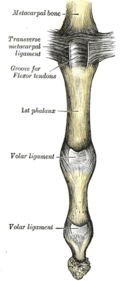Metacarpophalangeal joints
| Metacarpophalangeal joint | |
|---|---|

The palmar aspect of the hand showing the epiphyses of the hand exploded. MCP joints in red.
|
|

Metacarpophalangeal articulation and articulations of digit. Palmar aspect.
|
|
| Details | |
| System | 099 |
| Identifiers | |
| Latin | articulationes metacarpophalangeae |
| MeSH | A02.835.583.345.512 |
| Dorlands /Elsevier |
a_64/12161410 |
| TA | A03.5.11.501 |
| FMA | 35246 |
|
Anatomical terminology
[]
|
|
The metacarpophalangeal joints (MCP) are situated between the metacarpal bones and the proximal phalanges of the digits. These joints are of the condyloid kind, formed by the reception of the rounded heads of the metacarpal bones into shallow cavities on the proximal ends of the proximal phalanges. Being condyloid, they allow the movements of flexion, extension, abduction, adduction and circumduction at the joint.
Each joint has:
The dorsal surfaces of these joints are covered by the expansions of the Extensor tendons, together with some loose areolar tissue which connects the deep surfaces of the tendons to the bones.
The movements which occur in these joints are flexion, extension, adduction, abduction, and circumduction; the movements of abduction and adduction are very limited, and cannot be performed while the fingers form a fist.
The muscles of flexion and extension are as follows:
Arthritis of the MCP is a distinguishing feature of Rheumatoid Arthritis, as opposed to the distal interphalangeal joint in osteoarthritis.
In many quadrupeds, particularly horses and other larger animals, the metacarpophalangeal joint is referred to as the "fetlock." This term is translated literally as "foot-lock." In fact, although the term fetlock does not specifically apply to other species' metacarpophalangeal joints (for instance, humans), the "second" or "mid-finger" knuckle of the human hand does anatomically correspond to the fetlock on larger quadrupeds. For lack of a better term, the shortened name may seem more practical.
...
Wikipedia
